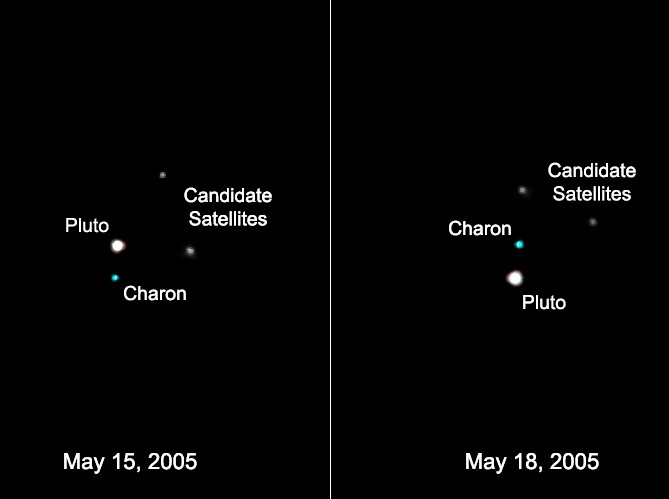Credit & Copyright: H. Weaver
(JHU /
APL),
A. Stern
(SwRI), and the
HST Pluto Companion Search Team,
ESA,
NASA
Explanation:
In 1930, tiny, icy world Pluto was
discovered orbiting
in the distant solar system.
In 1978, its relatively large companion
Charon
was detected
by ground-based observations.
This year, the Hubble
Space Telescope may well have detected two
further members of
the Pluto system.
Provisionally designated S/2005 P1 and S/2005 P2,
the two potential new moons are seen
orbiting in
a counterclockwise direction about
44,000 kilometers (27,000 miles) from Pluto in
these deep Hubble images
recorded only three days apart.
The diminutive and faint companions are also apparently detected
on Hubble images of Pluto from 2002, but
this coming February follow-up observations are planned in an effort to
confirm the discovery of the new moons.
Compared to Pluto's and Charon's diameters of 2,300 and
1,300 kilometers respectively, these moons are estimated to be
between 60 and 200 kilometers across.
Well within the Kuiper Belt,
an extensive region beyond the orbit of Neptune,
the Pluto system could be the first quadruple
Kuiper
Belt object known.
1999 2000 2001 2002 2003 2004 2005 2006 2007 2008 2009 2010 2011 2012 2013 2014 2015 2016 2017 2018 2019 2020 2021 2022 2023 2024 2025 |
Yanvar' Fevral' Mart Aprel' Mai Iyun' Iyul' Avgust Sentyabr' Oktyabr' Noyabr' Dekabr' |
NASA Web Site Statements, Warnings, and Disclaimers
NASA Official: Jay Norris. Specific rights apply.
A service of: LHEA at NASA / GSFC
& Michigan Tech. U.
|
Publikacii s klyuchevymi slovami:
Pluto - Moon - Pluton - Haron - sputniki planet
Publikacii so slovami: Pluto - Moon - Pluton - Haron - sputniki planet | |
Sm. takzhe:
Vse publikacii na tu zhe temu >> | |
